China-Kazakhstan zone creates jobs, stimulates trade
 |
|
Chinese tourists shop at a Kazakhstan store in the China-Kazakhstan Khorgos Frontier International Cooperation Center. [Photo by Ruo Yu/For China Daily] |
As day breaks, Marina gets out of bed, has breakfast and hops into a cab to start a day of busy work at the China-Kazakhstan Khorgos Frontier International Cooperation Center. She began to work as an interpreter at a Chinese trade firm two months ago.
Marina receives foreign clients and coordinates with relevant government departments of Kazakhstan. Before landing her job, she studied Chinese for a year in Ili, Xinjiang Uygur autonomous region, in Northwest China.
Marina is not the only person who shuttles every day between the two countries. Border trade is booming in Khorgos, an ancient town on the erstwhile Silk Road.
Trade is growing fast thanks to the Belt and Road Initiative, proposed by China to deepen economic cooperation through infrastructure development.
Hundreds of interpreters from China, Kazakhstan and other countries work at the Khorgos center. In addition to their salary, they sometimes get a bonus.
"Back in my hometown, I can earn only half the money I get here," Marina said.
The Khorgos Frontier International Cooperation Center straddles the China-Kazakhstan border. It occupies a total area of 5.28 square km, with 3.43 sq km in China and 1.85 sq km in Kazakhstan. It's the first trans-border international free trade zone in the world, and also China's first unique economic zone "within the country, but out of the jurisdiction of its customs".
The center started its operations in April 2012. The movement of personnel, vehicles and goods are unrestricted on its premises, and stores and visitors in the center are entitled to preferential policies, including taxation. There are more than 4,000 stores, including 40 duty-free shops in the center, with a staff of 6,000.
Lazarti comes from Xinjiang's Tekes county. The 22-year-old ethnic Kazakh found a job as an interpreter and salesman at the center after graduation.
He also helps sell imported Kazakhstan snacks such as candies and cookies, mainly to Chinese customers. He speaks Mandarin, Kazakh, and the Uygur languages.
"The work offers me an opportunity to meet people from other countries and broaden my horizons. These experiences would hopefully help me to start a business in the future," Lazarti said.
At 6 pm, the bustling trade center is at peace. After a full day's work, Marina jumps into a cab back to Yarkent, while Lazarti, bidding her farewell, walks towards his rented apartment on the Chinese side of the border.
- China-Kazakhstan oil refinery put into operation
- China-Kazakhstan ties a win-win
- China, Kazakhstan sign cooperation deals worth over $8b
- Cartoon commentary, Xi's Central Asia tour②: Injecting momentum to accelerate China-Kazakhstan all-round cooperation
- China, Kazakhstan move closer with Belt and Road cooperation




















